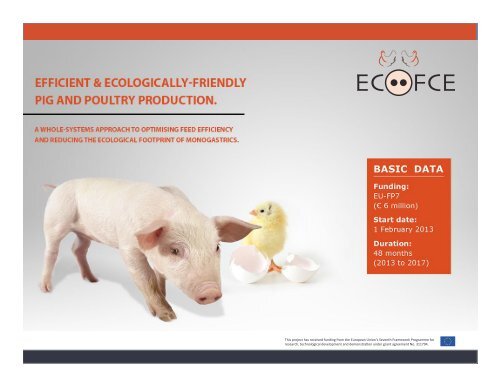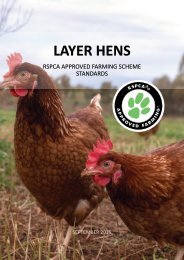Pigs-and-poultry_Improving-feed-efficiency_Ruminomics-ECOFCE-workshop-Aberdeen-16-June-2014
You also want an ePaper? Increase the reach of your titles
YUMPU automatically turns print PDFs into web optimized ePapers that Google loves.
This project has received funding from the European Union‘s Seventh Framework Programme for <br />
research, technological development <strong>and</strong> demonstraon under grant agreement No. 311794.
<strong>Improving</strong> <strong>feed</strong> <strong>efficiency</strong> by <br />
underst<strong>and</strong>ing the intesnal bacterial <br />
network in pigs <strong>and</strong> <strong>poultry</strong> <br />
Dr. Barbara Metzler-‐Zebeli <br />
Mr. Andor Molnar <br />
Ms. Janine Scholz <br />
University of Veterinary Medicine <br />
Vienna <br />
Dr. Stefan G. Buzoianu <br />
Dr. Peadar G. Lawlor <br />
Ms. Ursula McCormack <br />
Moorepark Research Centre, <br />
Teagasc, Irel<strong>and</strong> <br />
This project has received funding from the European Union‘s Seventh Framework Programme for <br />
research, technological development <strong>and</strong> demonstraon under grant agreement No. 311794.
Introducon <br />
This project has received funding from the European Union‘s Seventh Framework Programme for <br />
research, technological development <strong>and</strong> demonstraon under grant agreement No. 311794.
• Feb 2013 – Feb 2017 <br />
• 17 partners <br />
• 7 WPs <br />
• Overall objecves <br />
ECO-‐FCE overview <br />
• improve food security by opmising the <strong>feed</strong> <strong>efficiency</strong> in pigs <strong>and</strong> broilers <br />
without negavely affecng animal welfare <strong>and</strong> meat quality <br />
• reduce the ecological footprint of the pig <strong>and</strong> broiler producon systems <br />
• WP 3 objecve <br />
• to examine the gut structure, funcon, microbiota <strong>and</strong> metagenomics in <br />
animals divergent for <strong>feed</strong> <strong>efficiency</strong> <br />
This project has received funding from the European Union‘s Seventh Framework Programme for <br />
research, technological development <strong>and</strong> demonstraon under grant agreement No. 311794.
Work Package 3 <br />
Intesnal <br />
structure & <br />
funcon <br />
Genomics <br />
Genecs <br />
Low <br />
RFI <br />
Intesnal <br />
health <br />
High <br />
Medium <br />
Health & <br />
welfare <br />
Meat quality <br />
Animal <br />
performance <br />
Intesnal <br />
microbiota <br />
This project has received funding from the European Union‘s Seventh Framework Programme for <br />
research, technological development <strong>and</strong> demonstraon under grant agreement No. 311794.
Determinaon of <strong>feed</strong> <strong>efficiency</strong> <br />
Selecon of high <strong>and</strong> low <strong>feed</strong> efficient animals -‐ based on Residual Feed Intake <br />
Residual Feed Intake (RFI) = difference between observed <strong>and</strong> predicted <strong>feed</strong> <br />
intake, with lower RFI values indicang greater energy <strong>efficiency</strong> <br />
RFI = FI [a + b 1 * BW 0.75 + b 2 * BWG] <br />
Where a is the intercept <strong>and</strong> b 1 <strong>and</strong> b 2 are paral regression coefficients of <strong>feed</strong> intake <br />
(FI) on BW 0.75 <strong>and</strong> body weight gain (BWG), respecvely. <br />
Other measures of <strong>feed</strong> <strong>efficiency</strong> <br />
Feed <strong>efficiency</strong> = gain (g) / <strong>feed</strong> intake (g) <br />
Feed conversion rao (FCR) = <strong>feed</strong> intake <br />
(g) / gain (g) <br />
RG = BWG [a + b 1 * BW 0.75 + b 2 * FI] <br />
RIG = (RG/SD RG) -‐ (RFI/SD RFI) <br />
This project has received funding from the European Union‘s Seventh Framework Programme for <br />
research, technological development <strong>and</strong> demonstraon under grant agreement No. 311794.
Feed <strong>efficiency</strong> in monogastric livestock <br />
species <br />
Feed <br />
<strong>efficiency</strong> <br />
Genecs <br />
Diet <br />
Rearing <br />
environment <br />
Age <br />
Gut commensal microbiota <br />
Substanal variaon in <strong>feed</strong> <strong>efficiency</strong> between individual animals. <br />
Great variaon in gut commensal microbiota between individuals. <br />
This project has received funding from the European Union‘s Seventh Framework Programme for <br />
research, technological development <strong>and</strong> demonstraon under grant agreement No. 311794.
Role of the intesnal microbiota <br />
Benefits to the host <br />
intesnal maturaon <br />
inhibion of pathogen growth <br />
nutrient salvaging <br />
detoxificaon <br />
producon of vitamins <br />
Costs to the host <br />
compeon for nutrients <br />
immune acvaon <br />
producon of toxins <br />
opportunisc <br />
toxin reabsorpon <br />
mucolyc acvity <br />
This project has received funding from the European Union‘s Seventh Framework Programme for <br />
research, technological development <strong>and</strong> demonstraon under grant agreement No. 311794.
Effect of host microbiota on host metabolism <strong>and</strong> <br />
hormone secreon <br />
Intesnal microbiota can <br />
redirect energy <br />
paroning to adipose <br />
ssue <strong>and</strong> reduce fay <br />
acid oxidaon. <br />
Bäckhed (2011) Ann Nutr Metab 58(suppl 2):44 <br />
Implicaons for <strong>feed</strong> use <br />
<strong>efficiency</strong> <strong>and</strong> carcass <br />
composion in livestock <br />
animals? <br />
This project has received funding from the European Union‘s Seventh Framework Programme for <br />
research, technological development <strong>and</strong> demonstraon under grant agreement No. 311794.
Effect of gut microbiota composion on body <br />
weight <br />
Obese humans & mice: <br />
Firmicutes á <br />
Bacteroidetes â <br />
Low-‐calorie diet <br />
Firmicutes â <br />
Bacteroidetes á <br />
wikipedia.org <br />
Acnobacteria á <br />
Bacteroidetes â <br />
no difference in Firmicutes <br />
Changes in Lactobacillus <strong>and</strong> Bifidobacterium species <br />
Methanogenic archaea á <br />
Requena et al. (2013) Trends Food Sci Tech 34:44 <br />
Meat-‐producing monogastric livestock species are young, fast <br />
growing <strong>and</strong> lean animals <br />
Are the key players the same as in human obesity models ? <br />
This project has received funding from the European Union‘s Seventh Framework Programme for <br />
research, technological development <strong>and</strong> demonstraon under grant agreement No. 311794.
Chickens <br />
This project has received funding from the European Union‘s Seventh Framework Programme for <br />
research, technological development <strong>and</strong> demonstraon under grant agreement No. 311794.
Diet-‐related cecal microbiota <strong>and</strong> performance in <br />
male chickens <br />
Caecal microbial communies by diet Caecal microbial communies idenfied <br />
as being from birds with improved <br />
performance or poorer performance <br />
Diet is the most influencing factor affecng <strong>feed</strong> <strong>efficiency</strong>. <br />
Torok et al. (2011) AEM 77: 5868 <br />
This project has received funding from the European Union‘s Seventh Framework Programme for <br />
research, technological development <strong>and</strong> demonstraon under grant agreement No. 311794.
Batch to batch variaon in caecal microbiota <br />
of chickens <br />
3 different batches of chickens <br />
Very different microbiota <br />
profiles across chicken batches <br />
PCA plot of caecal microbiota. The plot <br />
is based on between groups (trials) <br />
analysis. <br />
Very different <strong>feed</strong> use <br />
efficiencies across chicken <br />
batches <br />
Stanley et al. (2013) PloS ONE 8(12): e84290 <br />
High variaon in caecal microbiota partly due to lack of colonisaon of the chickens by <br />
maternally derived bacteria <br />
⇒ High hygiene levels in modern commercial hatcheries remove natural bacteria <br />
⇒ Environmental microbiota from transport boxes, first <strong>feed</strong> <strong>and</strong> staff people <br />
This project has received funding from the European Union‘s Seventh Framework Programme for <br />
research, technological development <strong>and</strong> demonstraon under grant agreement No. 311794.
Fecal community of high <strong>and</strong> low <strong>feed</strong> efficient <br />
broiler chickens <br />
Low efficient chickens<br />
High efficient chickens<br />
12<br />
7<br />
Proteobacteria (%)<br />
18<br />
79<br />
Firmicutes (%)<br />
Bacteroidetes (%)<br />
28<br />
52<br />
Singh et al. (<strong>2014</strong>) J Appl Genet 55: 145 <br />
This project has received funding from the European Union‘s Seventh Framework Programme for <br />
research, technological development <strong>and</strong> demonstraon under grant agreement No. 311794.
Characterisaon of differences in gut microbiota <strong>and</strong> gut <br />
funcon of chickens with good <strong>and</strong> poor <strong>feed</strong> <strong>efficiency</strong> <br />
Experimental design: <br />
2 partner instuons (AFBI & Vetmeduni) performed idencal chicken experiments <br />
with 3 batches of 50/64 chicks <br />
Similar chicken genec: Cobb 500FF <br />
Similar maize-‐soybean meal diets (starter, grower, <strong>and</strong> finisher diets) <br />
No in-‐<strong>feed</strong> anbiocs <strong>and</strong> any other gut health-‐related addives <br />
Chickens were individually housed <br />
Best <strong>and</strong> worst <strong>feed</strong> efficient chickens were idenfied using Residual Feed Intake <br />
Ammonia<br />
Metagenomics Metagenomics Metagenomics<br />
emission<br />
(faeces) (faeces) (faeces)<br />
(faeces)<br />
Weighing Weighing Weighing Weighing Weighing Weighing<br />
d1 d7 d14 d21<br />
d28 d35<br />
d42<br />
Daily <strong>feed</strong> intake<br />
On day 42, samples were collected for: <br />
Ileal <strong>and</strong> caecal digesta for metagenomics <strong>and</strong> microbial metabolites <br />
Tissue of duodenum, jejunum, ileum, caeca for gut funcon <strong>and</strong> structure <br />
This project has received funding from the European Union‘s Seventh Framework Programme for <br />
research, technological development <strong>and</strong> demonstraon under grant agreement No. 311794.
Residual <strong>feed</strong> intake of good <strong>and</strong> poor <strong>feed</strong> efficient <br />
broiler chickens <br />
300<br />
200<br />
Residual <strong>feed</strong> intake<br />
Male<br />
Female<br />
(g)<br />
100<br />
0<br />
Great variaon in residual <br />
<strong>feed</strong> intake <strong>and</strong> thus in <br />
<strong>feed</strong> use <strong>efficiency</strong>. <br />
-‐100<br />
-‐200<br />
-‐300<br />
Feed <strong>efficiency</strong>, P< 0.001<br />
Batch, P>0.1<br />
Good Average Poor<br />
This project has received funding from the European Union‘s Seventh Framework Programme for <br />
research, technological development <strong>and</strong> demonstraon under grant agreement No. 311794.
Microbial metagenome of good <strong>and</strong> poor <strong>feed</strong> efficient <br />
chickens <br />
Shotgun sequencing using MiSeq Technology <br />
(Illumina) <br />
Under construcon <br />
This project has received funding from the European Union‘s Seventh Framework Programme for <br />
research, technological development <strong>and</strong> demonstraon under grant agreement No. 311794.
Jejunal electrophysiological characteriscs of good <br />
<strong>and</strong> poor <strong>feed</strong> efficient broiler chickens <br />
Gut electrophysiology was performed using Ussing chamber technique. <br />
Tissue originated from the distal jejunum. <br />
200<br />
150<br />
100<br />
50<br />
0<br />
Tissue resistance (Ω/cm 2 )<br />
Females<br />
Feed <strong>efficiency</strong>, P=0.020<br />
b<br />
a<br />
Good Average Poor<br />
a<br />
14<br />
12<br />
10<br />
8<br />
6<br />
4<br />
2<br />
0<br />
Tissue conductance (mS x cm 2 )<br />
a<br />
b<br />
Females<br />
Feed <strong>efficiency</strong>, P=0.002<br />
b<br />
Good Average Poor<br />
1.6<br />
1.4<br />
1.2<br />
1.0<br />
0.8<br />
0.6<br />
0.4<br />
0.2<br />
0.0<br />
Short-‐circuit current (I sc ; µEq/cm 2 x hour)<br />
a<br />
ab<br />
Females<br />
Feed <strong>efficiency</strong>, P=0.076<br />
Good Average Poor<br />
b<br />
Good <strong>feed</strong> efficient females showed lower ssue resistance, higher conductance <strong>and</strong> <br />
short-‐circuit current indicang a higher ion flux <strong>and</strong> permeability of the jejunal mucosa <br />
Influencing factors: Host genome or gut microbiota ? <br />
This project has received funding from the European Union‘s Seventh Framework Programme for <br />
research, technological development <strong>and</strong> demonstraon under grant agreement No. 311794.
<strong>Pigs</strong> <br />
This project has received funding from the European Union‘s Seventh Framework Programme for <br />
research, technological development <strong>and</strong> demonstraon under grant agreement No. 311794.
Literature <br />
Lile data available in pigs <br />
↓ Bacteroidetes & ↑ Firmicutes in obese pigs (Pedersen et al., 2013) <br />
↑ Firmicutes & ↓ β-‐Proteobacteria in ERS-‐fed pigs (Haenen et al., 2013) <br />
Protein, CHO <strong>and</strong> lipid metabolic pathways affected by <br />
intesnal microbial profile <br />
mice (Antunes et al., 2011) <br />
pigs (Mulder et al., 2009) <br />
This project has received funding from the European Union‘s Seventh Framework Programme for <br />
research, technological development <strong>and</strong> demonstraon under grant agreement No. 311794.
Screening on <strong>feed</strong> <strong>efficiency</strong> in pigs <br />
46 liers <br />
<strong>Pigs</strong> <br />
divergent <br />
for RFI <br />
Common <br />
protocols <br />
Teagasc × 3 <br />
AFBI <br />
Vetmeduni <br />
Common <br />
diets <br />
Common <br />
genecs <br />
Common <br />
& site-specific<br />
<br />
boars <br />
weaning d 42 d 84 <br />
P <br />
F <br />
F <br />
P <br />
d 112 <br />
This project has received funding from the European Union‘s Seventh Framework Programme for <br />
research, technological development <strong>and</strong> demonstraon under grant agreement No. 311794.<br />
<br />
F I C <br />
F – faecal <br />
I – ileal digesta <br />
C – caecal digesta <br />
P – performance
Microbiota profiling <br />
d 0 (weaning) d 42 d 84 d 126 d 139 <br />
P <br />
P <br />
P <br />
P <br />
F F F F F I C <br />
Composional analysis <br />
<strong>16</strong>S rRNA gene sequencing <br />
Illumina <br />
Funconality <br />
Shotgun metagenomics <br />
F – faecal; I – ileal digesta; C – caecal digesta; P – performance <br />
This project has received funding from the European Union‘s Seventh Framework Programme for <br />
research, technological development <strong>and</strong> demonstraon under grant agreement No. 311794.
Progress on microbiota profiling <br />
Samples collected <br />
DNA extracted <br />
<strong>16</strong>S rRNA gene sequencing – results being analysed <br />
Shotgun metagenomics <br />
samples being prepared <br />
results ~ Oct <strong>2014</strong> <br />
This project has received funding from the European Union‘s Seventh Framework Programme for <br />
research, technological development <strong>and</strong> demonstraon under grant agreement No. 311794.
Manipulaon of GIT microbial profile <br />
Addives <br />
Microbial <br />
inoculaon <br />
Low RFI <br />
Management <br />
Nutrion <br />
This project has received funding from the European Union‘s Seventh Framework Programme for <br />
research, technological development <strong>and</strong> demonstraon under grant agreement No. 311794.
Inoculaon with faecal inoculum from good <strong>feed</strong> <br />
converters <br />
Anaerobically processed <br />
diluted 1:6 <br />
strained <br />
centrifuged (6000 × G for 15 minutes) <br />
frozen at -‐80°C in 10% glycerol <br />
No <br />
inoculum <br />
Sows <br />
Inoculum <br />
No <br />
inoculum <br />
Single <br />
inoculaon <br />
Mulple <br />
inoculaon <br />
Offspring <br />
No <br />
inoculum <br />
Single <br />
inoculaon <br />
Mulple <br />
inoculaon <br />
This project has received funding from the European Union‘s Seventh Framework Programme for <br />
research, technological development <strong>and</strong> demonstraon under grant agreement No. 311794.
Nutrional intervenon <br />
Opmum strategy – inoculum <br />
Prebiocs – alone or in combinaon <br />
Monitoring <strong>and</strong> sampling of offspring through their lifeme <br />
performance <br />
health <br />
intesnal microbiota <br />
This project has received funding from the European Union‘s Seventh Framework Programme for <br />
research, technological development <strong>and</strong> demonstraon under grant agreement No. 311794.
Acknowledgements <br />
ECO-‐FCE has received funding from the European Union’s <br />
Seventh Framework Programme for research, technological <br />
development <strong>and</strong> demonstraon (FP7 2007/2013) under grant <br />
agreement No. 311794 <br />
Teagasc Walsh Fellowship Programme <br />
This project has received funding from the European Union‘s Seventh Framework Programme for <br />
research, technological development <strong>and</strong> demonstraon under grant agreement No. 311794.
Thank you <br />
This project has received funding from the European Union‘s Seventh Framework Programme for <br />
research, technological development <strong>and</strong> demonstraon under grant agreement No. 311794.
This project has received funding from the European Union‘s Seventh Framework Programme for <br />
research, technological development <strong>and</strong> demonstraon under grant agreement No. 311794.
ECO-‐FCE <br />
Gut structure, funcon, microbiota <strong>and</strong> metagenomics <br />
Hypothesis: <br />
It is assumed that the gut microbiome of pigs <strong>and</strong> broiler chickens with good <strong>and</strong> <br />
poor <strong>feed</strong> use <strong>efficiency</strong> differs in key members, thereby influencing the <br />
intesnal <strong>and</strong> metabolic host response, producon <strong>efficiency</strong> <strong>and</strong> host health. <br />
Objecves: <br />
1. To enhance our underst<strong>and</strong>ing of the interacons between gut microbiome <strong>and</strong> host <br />
genome in pigs <strong>and</strong> chickens. This task will be achieved by employing cung-‐edge <br />
<strong>16</strong>S rRNA-‐specific <strong>and</strong> shotgun metagenomics. <br />
2. Using this improved underst<strong>and</strong>ing, strategies to improve <strong>feed</strong> conversion <strong>efficiency</strong> <br />
through gut microbiome manipulaon in embryonic <strong>and</strong> subsequent developmental <br />
stages will be developed. <br />
This project has received funding from the European Union‘s Seventh Framework Programme for <br />
research, technological development <strong>and</strong> demonstraon under grant agreement No. 311794.
Interacons between gut microbiome <strong>and</strong> host <br />
physiology <strong>and</strong> health <br />
NF-‐κB <br />
This project has received funding from the European Union‘s Seventh Framework Programme for <br />
research, technological development <strong>and</strong> demonstraon under grant agreement No. 311794.<br />
<br />
Bäckhed (2011) Ann Nutr Metab 58(suppl 2): 44; Twarziok et al. (<strong>2014</strong>) Mol Inf 33: 171







